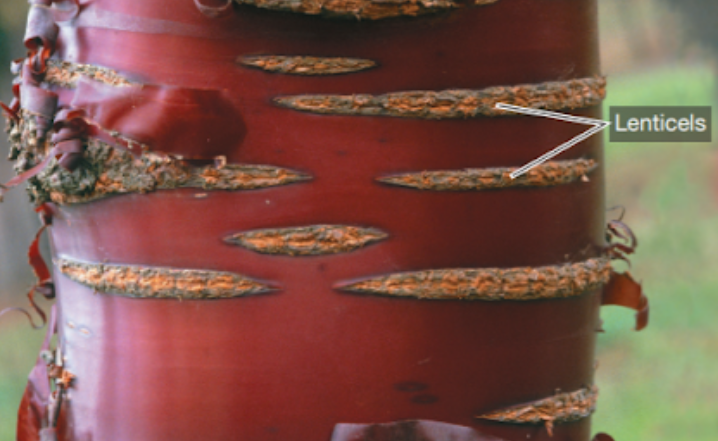
Lenticels are involved in
(a) Transpiration
(b) Gaseous exchange
(c) Food transport
(d) Photosynthesis
Answer
488.7k+ views
Hint: Lenticels are aerating pores which are formed in the cork in the tree.
Complete answer:
Lenticels are the small pores which are prominent in the cork through which the gaseous exchange takes place. Lenticels are often found in old dicot stems, the main function is known to be gas exchange. These are formed as a result of phellogen action. Lenticels appear as care on the stem surface and there are radial rows of cells present. These cells are thin-walled and are known as complementary cells.
Additional information:
- The increase in the thickness of a stem due to the activity of cambium and the cork cambium is known as the secondary growth.
-At the time of secondary growth the parenchymatous cells that are present in between the casual bundle form a strip of cambium known as the intrafascicular cambium.
-The cork cambium or the phellogen is developed from the outermost layer of the cortex, phelloderm or secondary cortex is produced on the inner side and on the outer side is phellem or cork. These 3 collectively are known as periderm.

So, the correct option is ‘gaseous exchange’.
Notes:
- The activity of cambium is not uniform and this leads to the formation of annual rings and different types of woods.
-In temperate conditions, the cambium is more active in spring and the wild form is the springwood. On the other hand, the activity of cambium is lesser during winter. The wood formed in dry summer or very cold winter is the autumn wood. Both these woods form a single growth/ annual ring.
Complete answer:
Lenticels are the small pores which are prominent in the cork through which the gaseous exchange takes place. Lenticels are often found in old dicot stems, the main function is known to be gas exchange. These are formed as a result of phellogen action. Lenticels appear as care on the stem surface and there are radial rows of cells present. These cells are thin-walled and are known as complementary cells.
Additional information:
- The increase in the thickness of a stem due to the activity of cambium and the cork cambium is known as the secondary growth.
-At the time of secondary growth the parenchymatous cells that are present in between the casual bundle form a strip of cambium known as the intrafascicular cambium.
-The cork cambium or the phellogen is developed from the outermost layer of the cortex, phelloderm or secondary cortex is produced on the inner side and on the outer side is phellem or cork. These 3 collectively are known as periderm.

Lenticels in a plant
So, the correct option is ‘gaseous exchange’.
Notes:
- The activity of cambium is not uniform and this leads to the formation of annual rings and different types of woods.
-In temperate conditions, the cambium is more active in spring and the wild form is the springwood. On the other hand, the activity of cambium is lesser during winter. The wood formed in dry summer or very cold winter is the autumn wood. Both these woods form a single growth/ annual ring.
Recently Updated Pages
What percentage of the area in India is covered by class 10 social science CBSE

The area of a 6m wide road outside a garden in all class 10 maths CBSE

What is the electric flux through a cube of side 1 class 10 physics CBSE

If one root of x2 x k 0 maybe the square of the other class 10 maths CBSE

The radius and height of a cylinder are in the ratio class 10 maths CBSE

An almirah is sold for 5400 Rs after allowing a discount class 10 maths CBSE

Trending doubts
The Equation xxx + 2 is Satisfied when x is Equal to Class 10 Maths

Why is there a time difference of about 5 hours between class 10 social science CBSE

Change the following sentences into negative and interrogative class 10 english CBSE

Write a letter to the principal requesting him to grant class 10 english CBSE

Explain the Treaty of Vienna of 1815 class 10 social science CBSE

Write an application to the principal requesting five class 10 english CBSE




